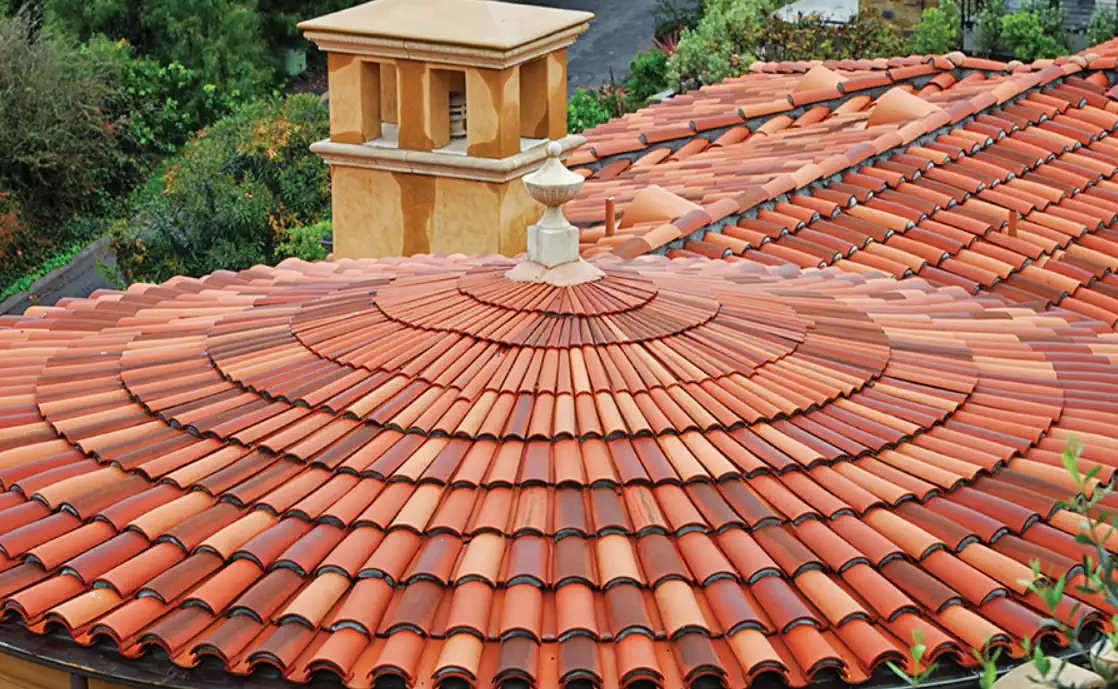What is Clay Tile Roofing?

Clay Tile Roofing – What It Is, Why It’s Great, and How Climate Matters
1. What Are Clay Tile Roofs?
- Material: Fired clay (usually red or tan) that’s shaped into long, flat “tiles” or curved “shingles.”
- Construction: Typically laid in overlapping rows, starting at the eave and moving up the roof. A ridge cap (a curved or specially shaped tile) crowns the top.
- Installation Steps:
- Roof Deck & Framing: Ensure the roof deck is solid and that rafters or trusses can support the added weight (clay tiles can weigh 1–2 lb per sq ft, up to 4–6 lb per sq ft for large slate‑style tiles).
- Underlayment: Install a moisture‑resistive barrier (e.g., synthetic felt, ice‑and‑water shield).
- Starter Strip: Lay a row of starter tiles along the eave to lock the tiles in place.
- Tile Laying: Overlap each new row by about 2–3 in. The upper row may be cut to fit the roof’s slope or profile.
- Ridge Cap: Install the cap tiles to seal the roof’s apex and prevent water ingress.
- Flashing & Ventilation: Add metal flashings at valleys, chimneys, skylights, and vents; ensure proper ventilation to keep the roof dry.
2. Key Benefits of Clay Roof Tiles
| Benefit | Why It Matters |
|---|---|
| Longevity | Clay tiles can last 50–100 years (and longer in some cases). Many historic structures still rely on clay roofs. |
| Durability | Resistant to fire, rot, termites, and high winds (especially if properly installed). |
| Aesthetic Variety | Classic red, earthy tan, or decorative patterns. Adds architectural character to homes and commercial buildings. |
| Low Maintenance | Once installed, minimal upkeep—just occasional cleaning of debris and checking for broken tiles. |
| Thermal Performance | Thick tiles provide excellent insulation, reflecting heat in summer and retaining warmth in winter. |
| Sound Dampening | Clay’s mass reduces wind and rain noise. |
| Environmental Friendly | Fired from natural clay; recyclable at the end of life. Does not off‑gas harmful chemicals. |
3. Climate Considerations
| Climate Factor | Clay Tile Suitability | What to Watch For |
|---|---|---|
| Hot, Sunny Regions | Excellent – clay reflects solar radiation, keeping the building cooler. | Ensure proper ventilation to avoid heat buildup in attic spaces. |
| Cold, Snowy Areas | Good – inherent insulation reduces heat loss. | The weight of snow can be a concern; strong framing is essential. Use a low‑pitch roof (over 30°) to allow snow to slide off or install a “snow‑gutter” system. |
| High Wind Zones | Very Good – thick tiles resist uplift if secured with metal straps or proper flashing. | Use a wind‑rated design; verify local building codes for wind load. |
| Humid or Rainy Climates | Very Good – clay does not absorb water, preventing rot. | Ensure continuous flashing and a high‑quality underlayment to avoid leaks. |
| Seismic Zones | Moderately Good – clay’s mass can be a drawback. | Install seismic straps or a reinforcement system; use a lighter tile (e.g., “clay‑blended” composite) if needed. |
| Urban/Industrial | Great – fire resistance is a plus. | Verify local fire rating requirements and any zoning restrictions. |
Quick Tips for Matching Clay Tiles to Your Climate
- Measure the Roof Pitch: Clay tiles work best on roofs between 20–45° pitch (sloped enough for drainage but not too steep for weight). High‑pitch roofs (above 45°) can use lighter tiles or alternative roofing materials.
- Check Structural Capacity: Before installation, confirm the load-bearing capacity of rafters/trusses; add plywood or composite decking if necessary.
- Use Proper Flashing: In rain‑heavy areas, metal flashings are critical to prevent water leaks at seams, valleys, and penetrations.
- Plan for Snow: In snowy climates, integrate a “snow ridge” or use a double‑layer tile system to reduce weight on joints.
- Ventilation Matters: A correctly vented attic keeps the tiles dry and extends their life, especially in humid or very hot regions.
4. Cost & Lifespan Snapshot
| Item | Approx Cost | Lifespan |
|---|---|---|
| Clay Tile (per sq ft) | $4–$8 | 50–100 yrs |
| Installation (per sq ft) | $5–$10 | — |
| Maintenance (annual) | <$10 | — |
| Energy Savings (cooling) | Potential 5–10 % savings in hot climates | — |
Tip: Although upfront costs are higher than asphalt shingles, the long-term savings—both in replacement frequency and energy usage—often offset the initial outlay within 10–15 years. Ref: Roof tiles - Wiki
5. Bottom Line
Clay tile roofs bring a combination of durability, beauty, and energy efficiency that few modern materials can match. When your climate and structural setup align, they’re an investment that can last a century or more. For the best results, work with an experienced contractor who understands the nuances of clay tile installation, especially the heavy‑load requirements and proper seam flashings. With proper care, a clay tile roof will keep your home protected, comfortable, and stylish for generations.
CLICK HERE: to find the contractors for this service
